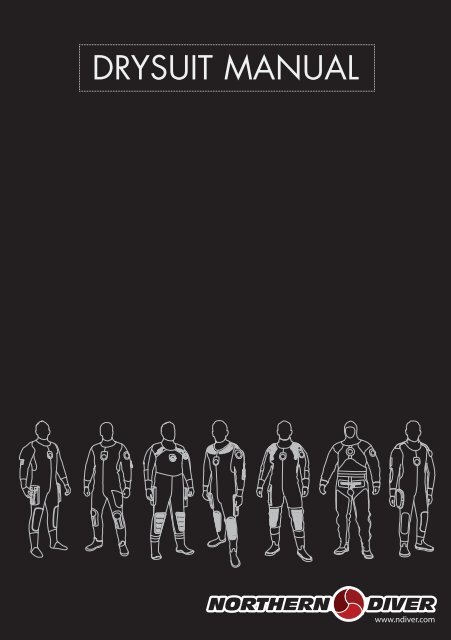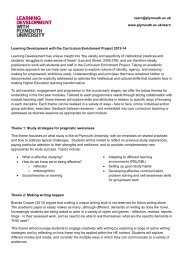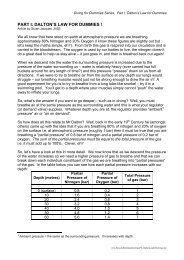DRYSUIT MANUAL
DRYSUIT MANUAL
DRYSUIT MANUAL
Create successful ePaper yourself
Turn your PDF publications into a flip-book with our unique Google optimized e-Paper software.
<strong>DRYSUIT</strong> <strong>MANUAL</strong><br />
www.ndiver.com
<strong>DRYSUIT</strong> <strong>MANUAL</strong> PAGE 2<br />
CONTENTS<br />
01<br />
02<br />
03<br />
About Your NorthErN DivEr DrYsuit 4<br />
PrEPAriNG Your DrYsuit for DiviNG 5<br />
2.1 Neoprene Neck seal<br />
2.2 Adjusting the Latex Neck seal 5<br />
2.3 Adjusting the Latex Wrist seal 6<br />
2.4 Attaching the inflation hose 6<br />
2.5 talcum Powder on Neck and Wrist seals 6<br />
Prior to DiviNG 7<br />
3.1 Putting on Your undersuit 7<br />
3.2 Putting on Your Drysuit 8<br />
3.3 Wrist seals 8<br />
3.4 Neck seals 8<br />
3.5 Closing the Zip 9<br />
3.6 venting the Drysuit 9<br />
3.7 Connecting/Disconnecting Your inflation hose 9<br />
04 usiNG AND MAiNtAiNiNG Your DrYsuit 10 1<br />
4.1 valves 10 9<br />
4.2 Zip 10 7<br />
4.3 before Diving 10 7<br />
4.4 After Diving 11 8<br />
4.5 Latex seals 11 8<br />
4.6 storage of Your Drysuit 11 8<br />
05 12<br />
troubLEshootiNG Your DrYsuit<br />
5.1 Zip Leaks<br />
5.2 seal Leaks<br />
5.3 valve Leaks<br />
5.4 suit fabric Leaks<br />
5.5 testing for Leaks<br />
5.5 repairing Leaks<br />
><br />
12<br />
12<br />
12<br />
12<br />
13<br />
13
<strong>DRYSUIT</strong> <strong>MANUAL</strong> PAGE 3<br />
06 thErMAL LAYEriNG 14 1<br />
6.1 range of thermal Products 14 9<br />
6.2 Drysuit/undersuit Layering Guide 15 7<br />
07 fittiNG thE NorthErN DivEr DrYGLovE sYstEM 16 1<br />
7.1 Attaching the Dryglove system to a Drysuit 16 9<br />
7.2 removing the Dryglove system from a Drysuit 17 7<br />
08 fittiNG hELios DrYGLovEs 18 1<br />
8.1 Adjusting and fitting helio Drygloves 18 7<br />
09 fittiNG A KNifE to A KNifE PoCKEt 19 1<br />
9.1 fitting a Knife to a Northern Diver Knife Pocket 19 7<br />
10 hEAvY-DutY shot-fiLLED ANKLE WEiGhts 20 1<br />
10.1 Assembling and filling Northern Diver Lead shot Ankle Weight 20 7<br />
11 rEfiLLs AND ACCEssoriEs<br />
21<br />
11.1 refills and other Northern Diver Product information<br />
12 iMPortANt iNforMAtioN<br />
22<br />
13 EMErGENCY ProCEDurEs 23 6<br />
13.1 inflator valve is stuck open<br />
23<br />
13.2 inflator valve is stuck Closed<br />
23<br />
13.3 Exhaust valve is stuck open<br />
23<br />
13.4 Exhaust valve is stuck Closed<br />
24<br />
13.5 Water Enters through Exhaust valve<br />
24<br />
13.6 Air Leaks through inflator valve<br />
24<br />
13.7 Drysuit becomes flooded<br />
24<br />
13.8 Dropped or Lost Weight belt<br />
24<br />
14 Your DrYsuit DEtAiLs<br />
25<br />
21
<strong>DRYSUIT</strong> <strong>MANUAL</strong> PAGE 4<br />
AbOUT YOUR NORThERN DIvER <strong>DRYSUIT</strong><br />
thank you for purchasing your new Northern Diver drysuit. if you<br />
are only used to diving in a wetsuit or semi-dry then you are in for<br />
a very pleasant surprise and will be pleased with the difference it<br />
will make to your diving.<br />
Drysuits are very simple to use but we<br />
strongly recommend that you practice your<br />
drysuit diving technique under controlled<br />
conditions in the presence of a qualified<br />
diving instructor before taking to the<br />
open water.<br />
if you have previous experience of drysuit<br />
diving we recommend that you read this<br />
manual for its safety tips and maintenance<br />
requirements.<br />
Northern Diver is based in Appley bridge<br />
in Lancashire where we use the latest<br />
technology combined with attention to<br />
detail and strict quality control to ensure<br />
your suit provides you with years of trouble<br />
free service. our fully integrated quality<br />
management system (which complies with<br />
TELEPhONE:<br />
FAX:<br />
EMAIL: info@ndiver.com<br />
WRITE/vISIT:<br />
bs EN iso 9001 & iso 9002) allows us to<br />
adopt a planned and disciplined approach<br />
to all aspects influencing quality. With the<br />
information in this manual you can ensure<br />
that your suit remains in good condition.<br />
if you find any part of this manual is not clear<br />
then don’t hesitate to contact us. similarly, if<br />
you are unable to understand any information<br />
about your drysuit, from whatever source, get<br />
in touch. We are here to help.<br />
if there is anything that isn’t included in<br />
this drysuit manual that you need to know<br />
then please get in touch with your nearest<br />
Northern Diver dealer. to find your nearest<br />
dealer worldwide please visit:<br />
www.ndiver.com/dealers<br />
UK – 01257 254444 INTERNATIONAL – 00 44 1257 254444<br />
UK – 01257 251234 INTERNATIONAL – 00 44 1257 251234<br />
Northern Diver (international) Ltd.<br />
Appley Lane North, Appley bridge<br />
Lancashire, WN6 9AE, uK<br />
WARNING : NorthErN DivEr stroNGLY rECoMMENDs thAt You uNDErGo<br />
trAiNiNG With A suitAbLY QuALifiED iNstruCtor bEforE tAKiNG<br />
to oPEN WAtEr With A DrYsuit.
<strong>DRYSUIT</strong> <strong>MANUAL</strong> PAGE 5<br />
PREPARING YOUR <strong>DRYSUIT</strong> FOR DIvING<br />
Prior to using your drysuit it<br />
is essential that you check<br />
whether you need to adjust<br />
your latex neck and wrist seals.<br />
if your suit has neoprene seals<br />
you may not need to adjust<br />
these.<br />
NEOPRENE NECK SEAL<br />
stock size neoprene seals become more<br />
supple with use. it is possible to stretch them<br />
by inserting a ball, bowl or bucket and leaving<br />
overnight. they often do not require any<br />
adjustment as there is sufficient tolerance and<br />
stretch within the material.<br />
ADJUSTING ThE LATEX NECK SEAL<br />
As latex seals are thin rubber they are easily<br />
adjusted with a pair of sharp scissors and<br />
careful attention. the seals are watertight and<br />
seal against the skin so a comfortable but<br />
effective fit is essential. the seals are tapered<br />
so as the edge is trimmed away the hole gets<br />
larger. if you are experienced at trimming<br />
seals you may be at ease doing it yourself.<br />
otherwise we suggest you contact your local<br />
approved Northern Diver centre and allow<br />
them to do all trimming.<br />
the first thing to do is measure your neck<br />
circumference at collar position. this is where<br />
your neck seal will seal against your skin. for<br />
the seal to work the latex must be slightly<br />
stretched so the hole needs to<br />
be smaller than the circumference of your<br />
neck. if the hole is the same size or larger then<br />
the neck seal will leak. ideally, the neck seal<br />
should be approximately 20% smaller than<br />
your collar circumference.<br />
firstly, turn your neck seal inside out where<br />
you will notice some parallel lines in the<br />
rubber. these are cutting guides to help you<br />
cut a straight line. remove material one ring<br />
at a time until you get a good fit. Do not try<br />
to remove the exact amount in one go as any<br />
errors may make the hole too big and the<br />
neck seal will not work. Also, use large scissors<br />
and try to avoid lots of little cuts. Longer cuts<br />
will help attain a clean edge. You may find it<br />
advantageous to enlist the help of another set<br />
of hands when trimming your neck seal.<br />
if you are unfamiliar with latex seals you may<br />
feel that your neck seal is still too tight after<br />
you have trimmed it to the correct size but<br />
when in the water you are likely to find that<br />
the fit is a comfortable and snug one.<br />
test your seal adjustments in a swimming<br />
pool before taking to open water.<br />
WARNING : to AvoiD ANY uNNECEssArY risK of bLooD rEstriCtioN ENsurE<br />
thAt Your NECK sEAL is Not too tiGht
<strong>DRYSUIT</strong> <strong>MANUAL</strong> PAGE 6<br />
PrEPAriNG Your DrYsuit for DiviNG – CoNtiNuED<br />
ND standard (hansen)<br />
seaquest<br />
CEJN<br />
ADJUSTING ThE LATEX<br />
WRIST SEAL<br />
CEJN type. bulbous<br />
end, large hole<br />
if you have adjustable latex seals on the wrists<br />
of your drysuit, they may only need trimming<br />
if you have large wrists. use a similar technique<br />
to that used for trimming the neck seal,<br />
allowing the hole to be approximately 20%<br />
smaller than the diameter of your wrist when<br />
the circumference is measured. As previously,<br />
there needs to be some stretch for the seal to<br />
work properly so remove a little at a time. if too<br />
much rubber is trimmed the seal is likely to<br />
leak. Again, use large sharp scissors and make<br />
long cuts to ensure a cleaner cut.<br />
ANY DAMAGE CAUSED TO YOUR NECK<br />
SEAL OR <strong>DRYSUIT</strong> bY TRIMMING IS NOT<br />
COvERED bY YOUR WARRANTY.<br />
finally, the edge of all trimming should be<br />
as smooth as possible. Any rough or jagged<br />
edges are prone to tearing when the suit is<br />
worn. trim any uneven edge slightly to leave<br />
as smooth a finish as possible.<br />
ATTAChING ThE INFLATION hOSE<br />
Your Northern Diver drysuit is supplied with<br />
an inflation hose.<br />
hansen type or Pig<br />
Nose. sometimes has a<br />
bar or 2 holes<br />
this should be connected to your regulator’s<br />
first stage using a low pressure outlet. if you<br />
have any doubts about doing this please<br />
contact your approved Northern Diver centre<br />
or your equipment service centre.<br />
it is also possible that your drysuit may have<br />
the blowgun inflation system. Contact us if in<br />
doubt or refer to:<br />
www.ndiver.com/valves<br />
TALCUM POWDER ON NECK<br />
AND WRIST SEALS<br />
A talc container/dispenser is included with<br />
every Northern Diver membrane drysuit. Your<br />
drysuit wrist and neck seals should be lubricated<br />
with talcum powder prior to putting it on. Do<br />
not use perfumed talcum powder as this may<br />
damage the seals. Alternatively a mild soap or<br />
water based lubricant may be used * .<br />
* Always test the product on an old seal before using
<strong>DRYSUIT</strong> <strong>MANUAL</strong> PAGE 7<br />
PRIOR TO DIvING<br />
Ensure the drysuit zip opens and closes easily. if a lot of effort is<br />
required the zip should be lubricated with wax (a bar of soap can<br />
be used in an emergency). Make sure that none of the teeth are<br />
damaged – if any damage is suspected the suit should be taken to a<br />
Northern Diver centre for inspection and repair.<br />
if your suit has been in storage for more than<br />
a few weeks it should be inspected some days<br />
prior to leaving to go diving.<br />
before each dive, the inflator and exhaust<br />
valve should be checked by connecting<br />
the regulator to an air tank and connecting<br />
the inflator hose to the inflator valve. Press<br />
the suit inflator valve to test. to check the<br />
exhaust valve, the neck and wrist seals must<br />
be plugged to create an airtight seal. various<br />
items (eg, a bottle) can be used (see picture).<br />
inflate the suit until the exhaust valve begins<br />
to vent (you will hear the air escaping). Press<br />
the exhaust valve to check it is functioning<br />
correctly (the suit should begin to deflate). if<br />
your suit is fitted with a cuff dump it will vent<br />
as you inflate the suit.<br />
PUTTING YOUR UNDERSUIT ON<br />
Extra thermal protection can be gained by<br />
wearing items such as a Northern Diver<br />
rash guard or thermalskin (see page 14)<br />
underneath your undersuit.<br />
Always wear socks - We recommend Northern<br />
Diver thermal hotsocks. see page 14 for more<br />
information about socks).<br />
it is easiest to sit down and pull your<br />
undersuit on up to the waist.<br />
the Northern Diver range of undersuits, such<br />
as Metalux suits, have specially designed<br />
footloops which prevent the undersuit legs<br />
rucking up when putting on your drysuit.<br />
standing up will assist you in putting your<br />
arms into the undersuit.<br />
Do not use excessive force when getting the<br />
undersuit over your shoulders – if you have<br />
difficulty enlist the help of someone (and<br />
reciprocate when they need help!)<br />
finally, close the zip ensuring no fabric or<br />
underwear is caught in the zip teeth.<br />
Always wear socks! We recommend Northern<br />
Diver thermal hotsocks.<br />
Your feet will always perspire when diving<br />
and this water inevitably ends up at your feet.<br />
this can sometimes give the sensation of wet<br />
feet. so, for the same reason that you wouldn’t<br />
wear shoes without socks without getting<br />
damp feet, you need to wick the moisture<br />
away to avoid uncomfortable and smelly feet<br />
whilst drysuit diving.
<strong>DRYSUIT</strong> <strong>MANUAL</strong> PAGE 8<br />
Prior to DiviNG – CoNtiNuED<br />
PUTTING YOUR <strong>DRYSUIT</strong> ON<br />
Most Northern Diver drysuits are shoulder<br />
entry – video guides for all drysuit entry<br />
systems can be found online at<br />
www.ndiver.com/videos<br />
it is important to remove jewellery and<br />
watches before putting on your drysuit. these<br />
items can easily damage wrist and neck seals.<br />
open the drysuit zip fully. fold the torso of<br />
the suit inside out down to the waist. for ease<br />
of dressing, sit down and put your feet into<br />
the legs of the suit (if your suit has braces<br />
ensure they are on the outside of your legs as<br />
you insert your feet). stand up, pulling the suit<br />
up to your waist. slide your (optional) braces<br />
to a good but not too tight fit.<br />
WRIST SEALS<br />
some under suits, such as the Northern Diver<br />
flectalon range, have thumb loops which<br />
assist in preventing the undersuit rucking<br />
up when inserting your hands through wrist<br />
seals.<br />
insert one arm into the suit sleeve. A couple<br />
of fingers from your other hand can help<br />
the seal pass over your hand. take care as<br />
long fingernails can damage the seal. Keep<br />
your fingers together as you push your hand<br />
through the seal.<br />
the wrist seal should be flat against your<br />
wrist. Ensure there is no material from your<br />
undersuit trapped beneath the seal as this<br />
may cause a leak. if you have any channels<br />
caused by tendons when you move your<br />
hand, pull the wrist seal as far as you can<br />
up your forearm. the procedure should be<br />
repeated for the other arm.<br />
NEOPRENE WRIST SEALS MAY bE<br />
LUbRICATED WITh NORThERN DIvER<br />
RUbbATEX NEOPRENE <strong>DRYSUIT</strong> SEAL<br />
LUbRICANT. TALCUM POWDER MAY bE<br />
USED FOR LATEX SEALS.<br />
NECK SEALS<br />
Put both hands through the top opening<br />
of your neck seal. Grip the edge of the seal<br />
(fingers inside the opening, thumbs on the<br />
outside) and spread the seal, taking care to<br />
avoid damage to the seal from your<br />
><br />
CAUTION : tAKE CArE With fiNGErNAiLs AND NECK & Wrist sEALs<br />
CAUTION : ENsurE NothiNG is trAPPED uNDEr NECK & Wrist sEALs
<strong>DRYSUIT</strong> <strong>MANUAL</strong> PAGE 9<br />
Prior to DiviNG – CoNtiNuED<br />
fingernails. turn your head slightly to one<br />
side and pull the neck seal over your head,<br />
keeping the seal spread with your fingers. Pull<br />
the neck seal down as you push up with your<br />
head.<br />
Divers with long hair will find it easier to fit<br />
the seal if wearing a nylon stocking over their<br />
hair. Latex will slide easily over the stocking.<br />
the neck seal should be adjusted so that it<br />
lies flat against your neck after it is over your<br />
head. turn the edge of the seal so that it sits<br />
between one and two inches above your<br />
collar bone. Ensure the seal is even around<br />
your neck with no hair or undersuit trapped<br />
underneath it as this may cause the suit to<br />
leak.<br />
NEOPRENE NECK SEALS MAY bE<br />
LUbRICATED WITh NORThERN DIvER<br />
RUbbATEX NEOPRENE <strong>DRYSUIT</strong> SEAL<br />
LUbRICANT. TALCUM POWDER MAY bE<br />
USED FOR LATEX SEALS.<br />
CLOSING ThE ZIP<br />
Do not attempt to close the zip yourself, enlist<br />
the help of your diving buddy.<br />
Your arms should be held at shoulder level<br />
in front of you. the zip should be pulled with<br />
a steady even action ensuring that there is<br />
no hair or clothing caught in the zip. the<br />
zip should be hard against the stop when<br />
fully closed. it is essential that the zip is fully<br />
docked with the rubber stop to<br />
avoid leaks.<br />
vENTING ThE <strong>DRYSUIT</strong><br />
Now you are fully enclosed in your drysuit<br />
you will be sharing it with some trapped air.<br />
this air should be vented from your suit –<br />
crouch down and cross your arms across your<br />
chest. Press the exhaust valve and you should<br />
hear the trapped air escaping. You may wish<br />
to repeat the procedure if any trapped air<br />
remains in the suit.<br />
if your suit does not have a push button<br />
exhaust valve, air may be expelled from the<br />
suit by pulling the neck seal away from the<br />
neck when crouching down.<br />
You are now ready to put your diving rig on.<br />
You may find this easier if you sit down and<br />
enlist the help of your diving buddy again.<br />
CONNECTING/DISCONNECTING<br />
YOUR INFLATION hOSE<br />
the inflator hose from your regulator first<br />
stage should be fed beneath your arm.<br />
to connect it to the inflator valve on your<br />
drysuit hold the hose just behind the fitting<br />
and pull the collar back. this collar is spring<br />
loaded and will slide back when you let go<br />
of it. holding the collar back, push the end of<br />
the hose onto the inflator valve fitting. Push<br />
the collar forward to lock it in position. Ensure<br />
the hose is attached properly and push the<br />
inflator button to check that it is functioning<br />
properly.<br />
to remove the hose, hold the end of the hose<br />
just behind the fitting and push it towards the<br />
inflator valve. hold the hose in this position<br />
and pull back on the spring loaded collar. this<br />
should disconnect the hose from the inflator<br />
valve.<br />
the inflator hose should connect and<br />
disconnect from the inflator valve regardless<br />
of whether your air tank is turned on or off.<br />
CAUTION : A buoYANCY CoMPENsAtor (stAb JACKEt, AbLJ, bC, etc.) is EssENtiAL<br />
for DrYsuit DiviNG You shouLD Not DEPEND oN Your DrYsuit As<br />
Your oNLY sourCE of buoYANCY<br />
CAUTION : ENsurE thE iNfLAtor hosE hAs A CLEAr PAth to Your iNfLAtor<br />
vALvE With No tiGht bENDs or KiNKs<br />
CAUTION :<br />
ENsurE Your iNfLAtioN hosE hAs Not bECoME CoNtAMiNAtED<br />
With Dirt or GrAvEL froM CoNtACt With thE GrouND. this MAY<br />
CAusE thE iNfLAtioN hosE or vALvE to MALfuNCtioN.
<strong>DRYSUIT</strong> <strong>MANUAL</strong> PAGE 10<br />
USING AND MAINTAINING YOUR <strong>DRYSUIT</strong><br />
With the correct maintenance,<br />
your Northern Diver drysuit<br />
will give you many years of<br />
enjoyable diving.<br />
having finished your day’s diving, rinse the<br />
outside of the suit thoroughly with fresh<br />
clean water to remove any dirt, sand or salt<br />
(ocassionally rinse the inside, which can also<br />
be treated with a proprietry deodourizer).<br />
Any stubborn stains can be removed by<br />
rubbing the area gently with soapy water.<br />
After you have rinsed out the suit, hang it over<br />
a drying rack or line in a shady spot. Northern<br />
Diver supply a special hanger designed for<br />
this purpose (to purchase a hanger contact<br />
your local dealer).<br />
NEvER LEAvE YOUR SUIT IN ThE SUN – IT<br />
MAY CAUSE COLOURS TO FADE.<br />
vALvES<br />
After diving, always rinse the inlet and outlet<br />
valves with cold running fresh water. to flush<br />
the inlet valve, simply connect the valve to<br />
an air supply and operate whilst flushing the<br />
push button area with water. this will help<br />
prevent sand and debris entering the valve<br />
seals.<br />
ZIP<br />
the drysuit zip seals on the inside teeth<br />
and rubber surface. the zip needs special<br />
maintenance and attention.<br />
bEFORE DIvING<br />
Close the zip and lubricate it with Northern<br />
Diver’s Zip Wax or Zip oil.<br />
A complimentary pack has been provided<br />
with your new suit. replacements can be<br />
ordered from Northern Diver or your<br />
local dealer (www.ndiver.com/dealers).<br />
WARNING : vALvEs Must bE ProPErLY CLEANED AftEr EvErY DivE.<br />
vALvEs MAY stiCK oWiNG to A buiLD uP of sALt, Dirt, hAir, etc.<br />
usE thE sAME rEsPECt AND CArE As You WouLD for A brEAthiNG<br />
rEGuLAtor<br />
-<br />
+<br />
-<br />
+<br />
>
AFTER DIvING<br />
<strong>DRYSUIT</strong> <strong>MANUAL</strong> PAGE 11<br />
usiNG AND MAiNtAiNiNG Your DrYsuit – CoNtiNuED<br />
the zip must be fully opened before<br />
attempting to remove your drysuit. failure to<br />
open completely may result in the zip being<br />
damaged. Clean the zip by rinsing with fresh<br />
water. if the zip is particularly dirty with sand<br />
or dirt after diving it can be cleaned by using<br />
a toothbrush and fresh water (mild soapy<br />
water can be used for heavy soiling).<br />
Lubricate the zip with Northern Diver’s<br />
bees Wax (or Zip oil) by rubbing the brass<br />
components before each new dive and after<br />
cleaning. it is important to do this – if not<br />
regularly lubricated the zip may seize up and<br />
possibly fail.<br />
LATEX SEALS<br />
Latex seals will perish quickly if any kind of<br />
moisturising cream, body oils or oil is applied<br />
to them. After dives clean the seals using mild<br />
soapy water to remove dirt and body oils.<br />
STORAGE OF YOUR <strong>DRYSUIT</strong><br />
once the drysuit valves are thoroughly clean<br />
and dry and the zip lubricated, you should<br />
store your drysuit in a cool dry place away<br />
from direct sunlight and devices that produce<br />
ozone such as motors and heaters. Also do<br />
not store your drysuit in areas accessible to<br />
cats or rodents (drysuits are good for nesting!)<br />
it is preferable that the suit is stored hung up<br />
with the zip closed.<br />
WARNING : Do Not rEGuLArLY usE siLiCoN sPrAY to LubriCAtE Your DrYsuit<br />
ZiP. this CAN DAMAGE thE suit AND thE MAtEriAL usED As thE<br />
bAsE of thE ZiP<br />
MILITARY SUIT<br />
WARNING :<br />
if Your suit is fittED With AN ANti-MAGNEtiC ZiP, thE ZiP sLiDEr is<br />
CoNNECtED to thE ZiP PuLLEr bY A sPECiAL broNZE WirE.<br />
You WiLL KNoW WhEN Your ZiP is bEYoND thE rEALMs of<br />
NorMAL LubriCAtioN WhEN You trY to CLosE thE ZiP AND thE<br />
WirE DEtAChEs froM thE sLiDEr. to PrEvENt this, LubriCAtE<br />
bEforE vErY usE.
<strong>DRYSUIT</strong> <strong>MANUAL</strong> PAGE 12<br />
TROUbLEShOOTING YOUR <strong>DRYSUIT</strong><br />
QUESTION : IS MY SUIT LEAKING OR IS IT CONDENSATION?<br />
rEMEMbEr, You WiLL ProbAbLY ProDuCE A NotiCEAbLE AMouNt<br />
of PErsPirAtioN WhEN DiviNG<br />
there are often several reasons for problems encountered with<br />
diving drysuits - below are some of the more common.<br />
ZIP LEAKS<br />
1] the zip is not fully closed<br />
2] the zip is damaged or has failed. Ensure<br />
the zip is fully open when putting on and<br />
removing the drysuit<br />
3] sand, dirt or salt has become trapped in the<br />
zip when opening or closing.<br />
4] improper or inadequate lubrication of the<br />
zip.<br />
5] under garments have become trapped in<br />
the zip.<br />
6] the zip has been over-stressed.<br />
7] the zip is very old or has been subjected to<br />
heavy usage.<br />
SEAL LEAKS<br />
1] Drysuit under garments are caught<br />
beneath the seal.<br />
2] hair is caught beneath the seal.<br />
3] Wrinkles or folds in the seals.<br />
4] improper adjustment of the seals resulting<br />
in channels around tendons.<br />
5] Deterioration of the seal (cracks/tears) due<br />
to age or usage.<br />
6] over trimming (Latex seals only).<br />
7] holes caused by jewellery or<br />
over-pulling when putting on and<br />
taking off the drysuit.<br />
vALvE LEAKS<br />
1] the valve is not properly fastened to the<br />
drysuit and needs tightening, especially<br />
on neoprene suits where the neoprene is<br />
compressed.<br />
2] improper adjustment of the<br />
exhaust valve.<br />
3] the exhaust valve is jammed open.<br />
4] Minor leakage when the valve is closed.<br />
5] Dirt, sand, salt or debris in the valve.<br />
6] the valve parts are worn with age or heavy<br />
use.<br />
Your drysuit valves may not be genuine Northern Diver valves<br />
and may have been rebadged from another source. Always ensure<br />
genuine Northern Diver valves are used in your drysuit.<br />
SUIT FAbRIC LEAKS<br />
1] tears, punctures or splitting of the drysuit<br />
material.<br />
2] Cuts due to sharp objects.<br />
3] failure of the seams or chafing.<br />
4] Delamination of suit material due to age,<br />
use or exposure to chemicals.<br />
>
TESTING FOR LEAKS<br />
<strong>DRYSUIT</strong> <strong>MANUAL</strong> PAGE 13<br />
troubLEshootiNG Your DrYsuit – CoNtiNuED<br />
should you wish to test your drysuit for leaks,<br />
carefully plug the wrist and neck seals. A<br />
bottle or similar object may be used for this.<br />
Connect the inflator hose to an air supply and<br />
the suit and inflate the suit. immerse the suit<br />
in a bath or suitable water container and look<br />
for any bubbles.<br />
Pouring soapy water over the offending area<br />
also easily identifies any leaks.<br />
An alternative method is to put the drysuit on,<br />
inflate it and have a friend pour soapy water<br />
solution around the suspect area. Any leaks<br />
should be obvious by soapy bubbles being<br />
formed.<br />
REPAIRING A LEAK<br />
having located the leak, as described above,<br />
ensure the drysuit is completely dry. Wear<br />
protective gloves (such as latex) to protect<br />
your hands. Clean the leak area by rubbing<br />
with sand paper and remove loose particles.<br />
Apply three layers of suitseal, allowing 15<br />
minutes drying time between each layer.<br />
Choose a suitably sized patch and remove the<br />
backing. Apply suitseal solution on the patch,<br />
allow to dry, apply a second layer and allow to<br />
dry, then apply a third layer. Allow to dry and<br />
apply the patch to cover the damaged area.<br />
use a roller over the patch to remove any air<br />
bubbles and to ensure the surfaces are firmly<br />
bonded.<br />
Allow 3 hours for the suitseal to dry and<br />
perform a pressure test (see previous section<br />
above) to ensure the leak has been repaired.<br />
if you encounter any problems contact<br />
your nearest Northern Diver diver dealer for<br />
assistance.
<strong>DRYSUIT</strong> <strong>MANUAL</strong> PAGE 14<br />
ThERMAL LAYERING<br />
An important aspect of drysuit diving is selecting most suitable<br />
undergarments for any particular dive. As your drysuit can be worn<br />
all year round, it is likely that you will need more insultaion in the<br />
winter and lighter insulation in the summer.<br />
Not forgetting comfort as well as warmth!<br />
Ensuring that moisture, including perspiration,<br />
doesn’t become uncomfortable is all part<br />
of the process of selecting what to wear<br />
beneath your drysuit.<br />
A sometimes overlooked layer for warmth<br />
and comfort can be found in our range of<br />
unique, teflon® coated lycra rash vests. the<br />
rash vests super-sheen outer finish allows<br />
gliding movement between thermal layers<br />
for extreme comfort. Combined with our<br />
hotmax® moisture-wicking fleece socks, the<br />
Layers range offers a huge choice for serious<br />
insulation in very cold conditions, lightweight<br />
insulation for less-cold situations or a<br />
variation of layers for conditions between the<br />
two extremes.<br />
www.ndiver.com/rashvests<br />
www.ndiver.com/hotsocks<br />
the Northern Diver thermalskin® is a fullbody<br />
base layer, featuring a mixture of<br />
moisture-wicking fleece and super-stretch<br />
lycra. thermalskin works with the rash vest<br />
and other layers to aid movement and<br />
increase thermal insultaion and comfort.<br />
www.ndiver.com/thermalskin<br />
Also available as part of the range is the<br />
thermalux® fleece & microfibre undersuit,<br />
suitable for lighter use in less severe<br />
conditions.<br />
www.ndiver.com/thermalux<br />
the layers range also includes Arctic system<br />
drysuit hoods with supervent and dry glove<br />
systems.<br />
www.ndiver.com/hoods<br />
www.ndiver.com/gloves<br />
Metalux® undersuits are available in three<br />
weights, 100, 200, and 300, 300 being the<br />
warmest by it’s method of maximum heat<br />
reflection and super-efficient insulation.<br />
www.ndiver.com/metalux<br />
Always wear socks! We recommend Northern Diver thermal hotsocks.
<strong>DRYSUIT</strong> <strong>MANUAL</strong> PAGE 15<br />
Choosing which drysuit and underwear combination to wear for<br />
different conditions can be confusing. below is Northern Diver’s<br />
rough guide for drysuit/underwear combination in the uK.<br />
Suit Type<br />
Suit Type<br />
Time of Year Suit Type LocationTime<br />
of Suggested Year Location Layering<br />
Time of Year Suit Type LocationTime<br />
of Suggested Year Location Layering<br />
Suggested Layering<br />
Suggested Layering<br />
Cortex Cordura<br />
Cortex Cordura<br />
Vortex Trilaminate<br />
Vortex Trilaminate<br />
Cortex Cordura<br />
Winter Cortex Cordura UK<br />
Winter Vortex TrilaminateUK<br />
Vortex Trilaminate<br />
Metalux 300 Undersuit<br />
Metalux Thermalskin 300 Undersuit<br />
Winter Thermalskin<br />
Hot SocksUK<br />
Winter Arctic Hot Extreme SocksHood<br />
UK<br />
Arctic Dry Extreme GlovesHood<br />
Dry Gloves<br />
Metalux 300 Undersuit<br />
Metalux Thermalskin 300 Undersuit<br />
Thermalskin<br />
Hot Socks<br />
Arctic Hot Extreme SocksHood<br />
Arctic Dry Extreme GlovesHood<br />
Dry Gloves<br />
Cortex Cordura<br />
Cortex Cordura<br />
Vortex Trilaminate<br />
Vortex Trilaminate<br />
Cortex Cordura<br />
Cortex Cordura<br />
Vortex Trilaminate<br />
Vortex Trilaminate<br />
Cortex Cordura<br />
Cortex Cordura<br />
Vortex Trilaminate<br />
Vortex Trilaminate<br />
Cortex Cordura<br />
SpringCortex<br />
Cordura UK<br />
Spring Vortex TrilaminateUK<br />
Vortex Trilaminate<br />
Cortex Cordura<br />
Summer Cortex Cordura UK<br />
Summer Vortex TrilaminateUK<br />
Vortex Trilaminate<br />
Cortex Cordura<br />
Autumn Cortex Cordura UK<br />
Autumn Vortex TrilaminateUK<br />
Vortex Trilaminate<br />
Metalux 300 Undersuit<br />
Metalux 300 Undersuit<br />
Spring<br />
Rash Vest<br />
Spring Hot Rash Socks Vest UK<br />
Hot Socks<br />
UK<br />
Dry Gloves<br />
Dry Gloves<br />
Rash Vest<br />
Metalux Rash 200 Vest Undersuit<br />
Summer Metalux 200 Undersuit UK<br />
Summer<br />
Hot Socks<br />
Hot Socks<br />
UK<br />
Superstretch Gloves<br />
Superstretch Gloves<br />
Rash Vest<br />
Metalux Rash 300 Vest Undersuit<br />
Autumn Metalux 300 Undersuit UK<br />
Autumn<br />
Hot Socks<br />
Hot Socks<br />
UK<br />
Dry Gloves<br />
Dry Gloves<br />
Metalux 300 Undersuit<br />
Metalux Rash 300 Vest Undersuit<br />
Hot Rash Socks Vest<br />
Dry Hot Gloves Socks<br />
Dry Gloves<br />
Rash Vest<br />
Metalux Rash 200 Vest Undersuit<br />
Metalux Hot 200 Socks Undersuit<br />
Superstretch Hot Socks Gloves<br />
Superstretch Gloves<br />
Rash Vest<br />
Metalux Rash 300 Vest Undersuit<br />
Metalux Hot 300 Socks Undersuit<br />
Dry Hot Gloves Socks<br />
Dry Gloves<br />
Suit Type<br />
Suit Type<br />
Time of Year Suit Type LocationTime<br />
of Suggested Year Location Layering<br />
Time of Year Suit Type LocationTime<br />
of Suggested Year Location Layering<br />
Suggested Layering<br />
Suggested Layering<br />
Divemaster<br />
Divemaster<br />
Winter Divemaster<br />
Winter Divemaster<br />
UK<br />
UK<br />
Metalux 200 Undersuit<br />
Metalux Thermalskin 200 Undersuit<br />
Winter Rash Thermalskin<br />
Vest, Hot Socks UK<br />
Winter Arctic Rash Vest, Extreme Hot Socks Hood UK<br />
Arctic Dry Extreme GlovesHood<br />
Dry Gloves<br />
Metalux 200 Undersuit<br />
Metalux Thermalskin 200 Undersuit<br />
Rash Thermalskin<br />
Vest, Hot Socks<br />
Arctic Rash Vest, Extreme Hot Socks Hood<br />
Arctic Dry Extreme GlovesHood<br />
Dry Gloves<br />
Divemaster<br />
Divemaster<br />
Divemaster<br />
Divemaster<br />
Divemaster<br />
Divemaster<br />
MEMbrANE DrYsuit 2.5mm hYPEr-CoMPrEssED NEoPrENE DrYsuit<br />
4mm hYPEr-CoMPrEssED NEoPrENE DrYsuit<br />
Spring Divemaster UK<br />
Spring Divemaster UK<br />
Summer Divemaster UK<br />
Summer Divemaster UK<br />
AutumnDivemaster<br />
UK<br />
AutumnDivemaster<br />
UK<br />
Metalux 100 Undersuit<br />
Metalux 100 Undersuit<br />
Spring<br />
Rash Vest<br />
Spring Hot Rash Socks Vest UK<br />
Hot Socks<br />
UK<br />
Superstretch Gloves<br />
Superstretch Gloves<br />
Rash Vest<br />
Thermalux Rash Vest Undersuit<br />
Summer Thermalux Undersuit<br />
Summer<br />
Hot SocksUK<br />
Hot Socks<br />
UK<br />
Superstretch Gloves<br />
Superstretch Gloves<br />
Rash Vest<br />
Metalux Rash 100 Vest Undersuit<br />
Autumn Metalux 100 Undersuit UK<br />
Autumn<br />
Hot Socks<br />
Hot Socks<br />
UK<br />
Superstretch Gloves<br />
Superstretch Gloves<br />
if you’re still unsure about what<br />
you need to wear for diving<br />
in the uK, around the world,<br />
summer, winter, inland or at<br />
sea, call Northern Diver for<br />
our expert advice on 01257<br />
254444 or drop us an email at<br />
info@ndiver.com.<br />
Alternatively, visit our website<br />
and ask any questions you may<br />
have using our online system at<br />
www.ndiver.com/contact<br />
Metalux 100 Undersuit<br />
Metalux Rash 100 Vest Undersuit<br />
Hot Rash Socks Vest<br />
Superstretch Hot Socks Gloves<br />
Superstretch Gloves<br />
Rash Vest<br />
Thermalux Rash Vest Undersuit<br />
Thermalux Hot Socks Undersuit<br />
Superstretch Hot Socks Gloves<br />
Superstretch Gloves<br />
Rash Vest<br />
Metalux Rash 100 Vest Undersuit<br />
Metalux Hot 100 Socks Undersuit<br />
Superstretch Hot Socks Gloves<br />
Superstretch Gloves<br />
WiCKiNG ProDuCts<br />
provides breathability for<br />
comfort and insulation<br />
PROTECTION FROM COLD WATER<br />
PROVIDED BY <strong>DRYSUIT</strong><br />
NEOPRENE LAYER<br />
Neoprene<br />
Metalux<br />
Thermalskin<br />
Rash Vest<br />
Suit Type<br />
Suit Type<br />
Time of Year Suit Type LocationTime<br />
of Suggested Year Location Layering<br />
Time of Year Suit Type LocationTime<br />
of Suggested Year Location Layering<br />
Suggested Layering<br />
Suggested Layering<br />
CNX25<br />
CNX25<br />
Winter<br />
Winter<br />
CNX25<br />
CNX25<br />
UK<br />
UK<br />
Metalux 200 Undersuit<br />
Metalux Thermalskin 200 Undersuit<br />
Winter Thermalskin<br />
Hot SocksUK<br />
Winter Arctic Hot Extreme SocksHood<br />
UK<br />
Arctic Superstretch Extreme Gloves Hood<br />
Superstretch Gloves<br />
Metalux 200 Undersuit<br />
Metalux Thermalskin 200 Undersuit<br />
Thermalskin<br />
Hot Socks<br />
Arctic Hot Extreme SocksHood<br />
Arctic Superstretch Extreme Gloves Hood<br />
Superstretch Gloves<br />
CNX25<br />
CNX25<br />
CNX25<br />
CNX25<br />
CNX25<br />
CNX25<br />
Spring CNX25 UK<br />
Spring CNX25 UK<br />
Summer CNX25<br />
Summer CNX25<br />
Autumn CNX25<br />
Autumn CNX25<br />
8mm NEoPrENE DrYsuit<br />
Metalux 200 Undersuit<br />
Metalux 200 Undersuit<br />
Spring<br />
Rash Vest<br />
Spring Hot Rash Socks Vest UK<br />
Hot Socks<br />
UK<br />
Superstretch Gloves<br />
Superstretch Gloves<br />
Rash Vest<br />
Metalux Rash 100 Vest Undersuit<br />
Summer Metalux 100 Undersuit UK<br />
Summer<br />
Hot Socks<br />
Hot Socks<br />
UK<br />
Superstretch Gloves<br />
Superstretch Gloves<br />
Rash Vest<br />
Metalux Rash 200 Vest Undersuit<br />
Autumn Metalux 200 Undersuit UK<br />
Autumn<br />
Hot Socks<br />
Hot Socks<br />
UK<br />
Superstretch Gloves<br />
Superstretch Gloves<br />
Seasonal Colour Key<br />
Seasonal Colour Key<br />
Spring Winter Summer<br />
Spring Winter Summer<br />
HEAT REFLECTED<br />
BY METALUX<br />
MOISTURE WICKED THROUGH<br />
RASH VEST AND THERMALSKIN.<br />
VAPOUR LOCKED IN METALUX LAYER<br />
SUPER-SHEEN TEFLON COATED<br />
RASH VEST ENSURES SMOOTH<br />
MOVEMENT OF LAYERS<br />
Seasonal Colour Key<br />
Seasonal Colour Key<br />
Spring Autumn Summer<br />
Spring Autumn Summer<br />
Metalux 200 Undersuit<br />
Metalux Rash 200 Vest Undersuit<br />
Hot Rash Socks Vest<br />
Superstretch Hot Socks Gloves<br />
Superstretch Gloves<br />
Rash Vest<br />
Metalux Rash 100 Vest Undersuit<br />
Metalux Hot 100 Socks Undersuit<br />
Superstretch Hot Socks Gloves<br />
Superstretch Gloves<br />
Rash Vest<br />
Metalux Rash 200 Vest Undersuit<br />
Metalux Hot 200 Socks Undersuit<br />
Superstretch Hot Socks Gloves<br />
Superstretch Gloves<br />
Suit Type<br />
Suit Type<br />
Time of Year Suit Type LocationTime<br />
of Suggested Year Location Layering<br />
Time of Year Suit Type LocationTime<br />
of Suggested Year Location Layering<br />
Suggested Layering<br />
Suggested Layering<br />
Origin 800<br />
Origin 800<br />
Winter Origin 800<br />
Winter Origin 800<br />
UK<br />
UK<br />
Metalux 100 Undersuit<br />
Metalux Thermalskin 100 Undersuit<br />
Winter Thermalskin<br />
Hot SocksUK<br />
Winter Arctic Hot Extreme SocksHood<br />
UK<br />
Arctic Dry Extreme GlovesHood<br />
Dry Gloves<br />
Metalux 100 Undersuit<br />
Metalux Thermalskin 100 Undersuit<br />
Thermalskin<br />
Hot Socks<br />
Arctic Hot Extreme SocksHood<br />
Arctic Dry Extreme GlovesHood<br />
Dry Gloves<br />
Origin 800<br />
Origin 800<br />
Origin 800<br />
Origin 800<br />
Origin 800<br />
Origin 800<br />
Winter<br />
Winter<br />
UK<br />
UK<br />
UK<br />
UK<br />
Spring Origin 800 UK<br />
Spring Origin 800 UK<br />
SummerOrigin<br />
800 UK<br />
SummerOrigin<br />
800 UK<br />
AutumnOrigin<br />
800 UK<br />
AutumnOrigin<br />
800 UK<br />
Thermalux Undersuit<br />
Thermalux Undersuit<br />
Spring<br />
Rash Vest<br />
Spring Hot Rash Socks Vest UK<br />
Hot Socks<br />
UK<br />
Superstretch Gloves<br />
Superstretch Gloves<br />
Thermalux Undersuit<br />
Thermalux Rash Vest Undersuit<br />
Summer Rash Vest<br />
Summer<br />
Hot SocksUK<br />
Hot Socks<br />
UK<br />
Superstretch Gloves<br />
Superstretch Gloves<br />
Thermalux Undersuit<br />
Thermalux Rash Vest Undersuit<br />
Autumn Rash Vest<br />
Autumn<br />
Hot SocksUK<br />
Hot Socks<br />
UK<br />
Superstretch Gloves<br />
Superstretch Gloves<br />
MOISTURE WICKED<br />
AWAY FROM FEET<br />
HEAT TRAPPED<br />
BY FLEECE LAYER<br />
Thermalux Undersuit<br />
Thermalux Rash Vest Undersuit<br />
Hot Rash Socks Vest<br />
Superstretch Hot Socks Gloves<br />
Superstretch Gloves<br />
Thermalux Undersuit<br />
Thermalux Rash Vest Undersuit<br />
Hot Rash Socks Vest<br />
Superstretch Hot Socks Gloves<br />
Superstretch Gloves<br />
Thermalux Undersuit<br />
Thermalux Rash Vest Undersuit<br />
Hot Rash Socks Vest<br />
Superstretch Hot Socks Gloves<br />
Superstretch Gloves<br />
Autumn<br />
Autumn
<strong>DRYSUIT</strong> <strong>MANUAL</strong> PAGE 16<br />
FITTING NORThERN DIvER DRY GLOvE SYSTEM<br />
Northern Diver’s Dryglove<br />
system fits neoprene,<br />
membrane & rubber drysuit<br />
seals including drysuit warmcuff<br />
systems<br />
ATTAChING ThE DRYGLOvE SYSTEM<br />
sealing ring in position<br />
inside the cuff<br />
1”<br />
these instructions demonstrate fitting the dryglove system<br />
to a neoprene cuff. for fitting to a warm cuff, ensure cuffs<br />
are tested and watertight before fitting and fit as for the<br />
neoprene cuff, noting that the suitseal must be applied 1” to<br />
2” below the stitching and not directly below stitching .<br />
www.ndiver.com/dryglove<br />
firstly place a fastening ring (note the thread faces the cuff ) over sleeve<br />
past the cuff ...<br />
... then insert the most suitable sized sealing ring into the cuff via the<br />
shoulder entry zip* into the position where the suitseal will be applied - you<br />
will need to squeeze the sealing ring through the fastening ring to reach<br />
the cuff, and a certain amount of manipulation and force will be required.<br />
* Note the tapered edge of the sealing ring faces the cuff and the stepped<br />
or sealing edge faces the shoulder.<br />
the suit cuff should have 3 coats of 1” width of suitseal applied, completely<br />
around the cuff ...
<strong>DRYSUIT</strong> <strong>MANUAL</strong> PAGE 17<br />
... which must be directly adjacent to the cuff<br />
stitching, and the suitseal should be worked into<br />
the material whilst being applied.<br />
Allow the first coat to dry, then apply a second<br />
coat which must be allowed to dry, then apply<br />
third and final coat. Allow this to dry.<br />
DISASSEMbLING ThE DRYGLOvE SYSTEM<br />
When the three applications of suitseal have<br />
cured, progress to fitting the glove locking socket<br />
to the cuff. the glove locking socket (threads<br />
first) is placed over the applied suitseal and<br />
manipulated over the ring for a very snug fit.<br />
the previously fitted threaded fastening ring<br />
is brought to marry up with the glove locking<br />
socket and tightened clockwise, (loosely by hand<br />
at this stage). it is necessary to manipulate the<br />
cuff to ensure it is central within the socket.<br />
once complete, use the fastening tool to tighten<br />
the fastening ring clockwise until it will turn no<br />
further (pressure is required). Prior to diving, the<br />
fastening ring should be further tightened to<br />
compensate for any neoprene compression.<br />
take the locking tool, slip it over the glove, locate onto the fastening ring. to<br />
unfasten turn anticlockwise until the fastening ring detaches and it is possible<br />
to pull the glove and sealing ring from the locking body.<br />
for more information and detailed fitting instructions, view the instructional<br />
DvD which is supplied with the Northern Diver Dryglove system.<br />
Also, visit www.ndiver.com/videos<br />
1 pair of Gloves assembled with<br />
Locking body<br />
1 x tube suitseal<br />
1 x Application brush<br />
sealing rings<br />
2 x small, 2 x Large<br />
2 x Locking socket<br />
2 x fastening ring<br />
1 x Locking tool
<strong>DRYSUIT</strong> <strong>MANUAL</strong> PAGE 18<br />
hELIOS XEROTECh GLOvES<br />
XErotECh gloves provide a<br />
simple, effective and economic<br />
solution to maintaining warm,<br />
safe and dry hands when<br />
diving. highly suitable for use in<br />
contaminated water.<br />
based on the patented design of auto-pressure<br />
compensation, so that changes in water depth<br />
do not destroy the insulation and dexterity of<br />
the glove, Xerotech wrist-sealing gloves are<br />
virtually squeeze-proof, within a depth range<br />
of 30 metres (100’). the specially designed<br />
wrist sealing membrane is carefully trimmed<br />
to optimise comfort and water-tightness to<br />
the wearer’s individual wrist size.<br />
Xerotech gloves work in a similar fashion as<br />
a diving drysuit, where insulation is provided<br />
by underwear and water-tightness by what<br />
is a flexible and tough seal. unlike a drysuit,<br />
Xerotech gloves don’t need an inflator. the<br />
specially designed air reservoir built in to the<br />
wrist seals adequately compensates pressure<br />
changes of at least 3 bar, and outside this<br />
range the gloves do not ‘squeeze’ as a drysuit<br />
would so always maintains good insulation<br />
invert the<br />
latex cuff and<br />
apply talcum<br />
Place fingers<br />
into the latex<br />
seal and<br />
spread open<br />
seal<br />
trimming the seals may be required to obtain optimum fit<br />
characteristics within the range of 30 metres<br />
depth (100’).<br />
the protection, comfort and dexterity that<br />
Xerotech gloves provide is the reason that<br />
they have become standard issue to NAto<br />
divers and many Police divers, where forensic<br />
search requires demanding levels of touch<br />
sensitivity, warmth and protection.<br />
Available in sizes 8, 9 & 10 (European hand<br />
sizes)<br />
if required, pressure compensation is achieved<br />
by passing air in and from the drysuit, using a<br />
small leak path facilitated by the undersuit’s<br />
thumb loop, a piece of material that breaches<br />
the suit’s wrist seal, or even a short section of<br />
drinking straw.<br />
1 3 5<br />
the glove<br />
can then<br />
easily be<br />
pulled into<br />
place<br />
2 4 6<br />
Extend the<br />
glove of<br />
the hand to<br />
show the<br />
seal<br />
overlap the<br />
glove seal onto<br />
the suit cuff<br />
seal or vice<br />
versa (personal<br />
preference)<br />
Push the<br />
Glove back<br />
onto the<br />
hand, and<br />
your ready<br />
to dive
<strong>DRYSUIT</strong> <strong>MANUAL</strong> PAGE 19<br />
FITTING A KNIFE TO A KNIFE POCKET<br />
Your Northern Diver drysuit may have a knife pocket fitted as<br />
standard or as an optional extra. fitting the knife to the pocket<br />
loops is very straightforward, just follow these instructions.<br />
Your pocket may not be identical to that shown in the diagrams<br />
but the method will be the same.<br />
1<br />
3<br />
5<br />
7<br />
Knife pocket<br />
without knife fitted<br />
fit velcro strap<br />
through knife<br />
scabbard<br />
fit velcro strap<br />
through webbing<br />
Press velcro strap<br />
onto backing velcro<br />
top lock<br />
2<br />
4<br />
6<br />
8<br />
remove velcro<br />
strap from beneath<br />
webbing loop<br />
fit knife scabbard<br />
into pocket<br />
feed velcro strap<br />
back through<br />
scabbard<br />
fit knife into<br />
scabbard
<strong>DRYSUIT</strong> <strong>MANUAL</strong> PAGE 20<br />
hEAvY-DUTY ShOT FILLED ANKLE WEIGhTS<br />
Northern Diver’s heavy-duty<br />
nylon ankle weights, with fastex<br />
buckle fastening, allow divers<br />
to fine-tune ankle weighting by<br />
using lead shot. follow these instructions to fill or adjust the ankle<br />
weights.<br />
size small - Max. capacity 0.4kg<br />
1<br />
2<br />
3<br />
4<br />
Detach sealing<br />
clip from the ankle<br />
weight tube<br />
open the ankle<br />
weight tube (where<br />
the clip has been<br />
removed) ready for<br />
filling with shot<br />
insert a funnel into<br />
the tube opening<br />
Pour shot into the<br />
funnel whilst lifting<br />
the tube allowing<br />
the shot to flow<br />
freely and fill the<br />
tube. Note - if no<br />
funnel is available<br />
shot can be poured<br />
directly into the<br />
tube<br />
size large - Max. capacity 0.7kg<br />
5<br />
6<br />
7<br />
8<br />
fit the sealing clip<br />
onto the tube<br />
turn the tube over<br />
and fit the locking<br />
clip on the other<br />
side and press fit<br />
When fastening for<br />
diving attach with<br />
the clip at front of<br />
the leg, rotate the<br />
ankleweight ...<br />
... until the Northern<br />
Diver logo is facing<br />
the front
<strong>DRYSUIT</strong> <strong>MANUAL</strong> PAGE 21<br />
REFILLS & ACCESSORIES<br />
in fact, Northern Diver<br />
manufacture and distribute<br />
everything any diver will ever<br />
need. Drysuits, undersuits,<br />
masks, fins, snorkels, gloves,<br />
boots, regulators, gauges, bCDs,<br />
bags, torches, and much more.<br />
Plus specialists equipment for<br />
commercial divers, including<br />
suits for contaminated water<br />
diving, search and rescue<br />
suits, military diver’s suits, and<br />
fire brigades and Coast Guard<br />
drysuits.<br />
for your copy of the latest<br />
drysuit and product brochures<br />
contact Northern Diver or visit<br />
www.ndiver.com/downloads<br />
refills for everything shown<br />
in this drysuit manual and<br />
any products demonstrated<br />
are available directly from<br />
Northern Diver or from any<br />
Northern Diver dealer.<br />
to find your nearest dealer visit<br />
www.ndiver.com/dealers<br />
or call us on 01257 254444.<br />
Did you know that Northern Diver is the tier 1 supplier to the uK<br />
armed forces, supplying the MoD with wetsuits, drysuits, thermal suits,<br />
specialist footwear and bags plus bespoke specialist equipment?
<strong>DRYSUIT</strong> <strong>MANUAL</strong> PAGE 22<br />
IMPORTANT INFORMATION<br />
1] follow all instructions. improper use of<br />
a drysuit can cause loss of buoyancy<br />
control including uncontrolled descents<br />
and ascents with a risk of serious injury or<br />
death.<br />
2] improper use or misuse of a drysuit can<br />
result in exposure to thermal hazards and<br />
rapid body overheating or cooling which<br />
could result in stroke, seizure, hypothermia<br />
and death.<br />
3] this manual is Not a substitute for proper<br />
qualified drysuit instruction and is not<br />
supplied as such. this manual is supplied as<br />
a guideline for drysuit maintenance only.<br />
4] Diving in conditions that contain chemical,<br />
biological or nuclear contaminants is<br />
extremely hazardous and should not be<br />
attempted without being specially trained<br />
and equipped. the Northern Diver suit you<br />
have purchased has not been adapted for<br />
use in polluted or abnormal conditions and<br />
is therefore not covered under warranty.<br />
5] Military drysuits - if you suit is to be used in conditions where the suit requires an nonmagnetic<br />
signature, please carry out adequate checks to confirm that the zips and valves<br />
fitted to your drysuit comply with your directive relating to this use. Non-magnetic inflation<br />
and exhaust valves can be identified with the following symbol:<br />
Non-magnetic symbol
<strong>DRYSUIT</strong> <strong>MANUAL</strong> PAGE 23<br />
EMERGENCY PROCEDURES<br />
Diving should never be undertaken without adequate training<br />
under qualified supervision. We offer some suggestions for<br />
rectifying problems on this page but this is merely scratching<br />
the surface and may not be suitable for any particular situation.<br />
remember, training in a safe environment with a suitably qualified<br />
instructor is essential.<br />
INFLATOR vALvE IS<br />
STUCK OPEN<br />
if your drysuit inflator valve becomes<br />
stuck open, meaning the suit is inflating<br />
uncontrollably, disconnect the inflation hose<br />
and press your dump valve at the same time.<br />
this exercise should be practised in a safe<br />
environment whilst wearing normal diving<br />
gloves. if you have a cuff dump you will be<br />
able to dump the excess air by raising your<br />
arm. in an extreme emergency, such as when<br />
you cannot vent sufficient air through the<br />
exhaust valve then you can raise you arm<br />
whilst lifting the seal on your wrist or by<br />
pulling the neck seal away from your skin.<br />
these procedures will allow air to escape from<br />
the suit quickly but will also allow water to<br />
enter the drysuit.<br />
if you experience an uncontrolled ascent due<br />
to over inflation it is important to exhale as<br />
you ascend.<br />
We recommend you do not undertake<br />
any diving without adequate back-up or<br />
redundancy in your bouyancy device (and<br />
having been trained in its use) to ensure a<br />
safe return to the surface.<br />
INFLATOR vALvE IS<br />
STUCK CLOSED<br />
use your training to assertain the correct<br />
method for regaining the surface, such as<br />
buoyancy control, ditching of weights, etc.<br />
EXhAUST vALvE IS<br />
STUCK OPEN<br />
if your drysuit exhaust valve becomes stuck<br />
open, your drysuit will not retain air and will<br />
therefore not give proper buoyancy. Water is<br />
also very likely to enter the suit via the valve.<br />
Abort the dive and use your buoyancy device<br />
to return to the surface and follow what was<br />
learned during your training.
<strong>DRYSUIT</strong> <strong>MANUAL</strong> PAGE 24<br />
EMErGENCY ProCEDurEs – CoNtiNuED<br />
EXhAUST vALvE IS<br />
STUCK CLOSED<br />
if your drysuit exhaust valve becomes stuck<br />
closed it may not be possible to vent air<br />
from your drysuit which could result in an<br />
uncontrollable ascent. Air can be dumped by<br />
pulling the wrist or neck seals away from the<br />
skin allowing air to escape. this action may<br />
cause water to enter the drysuit.<br />
WATER ENTERS ThROUGh<br />
EXhAUST vALvE<br />
this may be caused by dirt, etc. under the<br />
valve or a damaged diaphragm. Abort the<br />
dive immediately and use your buoyancy<br />
device to return to the surface.<br />
AIR LEAKS ThROUGh<br />
INFLATOR vALvE<br />
if this occurs you should disconnect the<br />
inflator hose from your drysuit and use your<br />
buoyancy device to return to the surface.<br />
Air will need to be dumped as usual when<br />
ascending.<br />
<strong>DRYSUIT</strong> bECOMES FLOODED<br />
in the unlikely event of this happening, it may<br />
be caused by a tear, seal or zip failure, etc. You<br />
should use your buoyancy device to return to<br />
the surface.<br />
it may help to keep the leaking area as low<br />
in the water as possible to help keep any<br />
remaining air in the suit. Cold water in the suit<br />
means that it should be removed as soon as<br />
possible after surfacing.<br />
be aware that it is normal for the inside<br />
of a drysuit to be damp with perspiration<br />
and a small amount of water should not<br />
be assumed to be because of a leak or suit<br />
failure.<br />
DROPPED OR LOST<br />
WEIGhT bELT<br />
if you intend to practise this procedure, you<br />
should do so only under the close supervision<br />
of a suitably qualified instructor in a<br />
controlled environment.<br />
Do not attempt to drop your weight belt<br />
until you are clear about the emergency<br />
procedures in your training.<br />
remember, dropping your weightbelt can<br />
injure other divers and other marine life.
<strong>DRYSUIT</strong> <strong>MANUAL</strong> PAGE 25<br />
YOUR <strong>DRYSUIT</strong> DETAILS<br />
PLEAsE NotE Your DrYsuit DEtAiLs for<br />
futurE rEfErENCE<br />
01<br />
02<br />
04<br />
05<br />
07<br />
DrYsuit sEriAL NuMbEr<br />
DAtE of PurChAsE<br />
suit tYPE<br />
siZE 06<br />
boot siZE<br />
NotEs (repairs, etc)<br />
03<br />
CoLour(s)
NORThERN DIvER WEIGhT & TRIM SYSTEM PAGE 26<br />
WEIGHT & TRIM<br />
Download all the information<br />
you’ll ever need about<br />
Northern Diver products at: www.ndiver.com/downloads
NORThERN DIvER WEIGhT & TRIM SYSTEM PAGE 27<br />
WEIGHT & TRIM<br />
A unique approach to managing weight and buoyancy allowing fine<br />
tuning your weight distribution.<br />
the Northern Diver Weight & trim is the most comfortable and ergonomic it has ever<br />
been. it has a loyal following of divers who swear by it’s ease of use and ability to trim<br />
the weight distribution around a diver’s body.<br />
once in use, the weights are securely fastened but can be easily and independently<br />
jettisoned if required. the pockets can be used for carrying weights or cargo and the<br />
attached knife loops fit the Northern Diver KN65 diving knife.<br />
• Padded shoulder straps for increased comfort & support<br />
• Independent quick-release weight system<br />
• Knife loops fit KN65 diving knife<br />
• Includes 2 detachable thigh pockets with drains<br />
• Each weight pocket is capable of holding up to 9kgs<br />
• Suitable for lead block or lead shot<br />
CYLINDER CLAMP SYSTEM<br />
the Northern Diver Cylinder<br />
Clamp system is manufactured<br />
from highly durable, anodised<br />
aluminium.<br />
the male (shorter) component<br />
attaches to the main cylinder<br />
using the bCD cylinder<br />
attachment straps/bands and<br />
the female (longer) component<br />
attaches to the pony cylinder<br />
using the included stainless<br />
steel clips. Protective rubbers<br />
prevent the clip damaging the<br />
tank paintwork. the main clamp<br />
assembly also has protective<br />
rubber inserts.<br />
Northern Diver (international) Ltd<br />
Appley Lane North Appley bridge<br />
Lancashire WN6 9AE uK<br />
tel: 01257 254444<br />
fax: 01257 251234<br />
email: info@ndiver.com<br />
Size Options:<br />
Size Waist Size + Suit Waist Size<br />
s–M 30–40” 26–36”<br />
L–XL 37–47” 33–43”<br />
XXL 44–54” 44”+<br />
the pony cylinder component simply slots into the main cylinder<br />
component and the locking pin is released when a secure<br />
connection has been made. the he clamp is released by pressing the<br />
locking pin and separating the cylinders.<br />
• Securely attaches pony bottle to<br />
main tank<br />
• Made from anodised aluminium<br />
• Quick and easy to use<br />
• 2-piece quick-release system<br />
• Rugged construction<br />
highly rated by Dive Magazine:<br />
“Easy to use, robust but lightweight”
NORTHERN DIVER (INTERNATIONAL) LTD<br />
APPLEY LANE NORTH APPLEY BRIDGE LANCASHIRE WN6 9AE UK<br />
www.ndiver.com

















